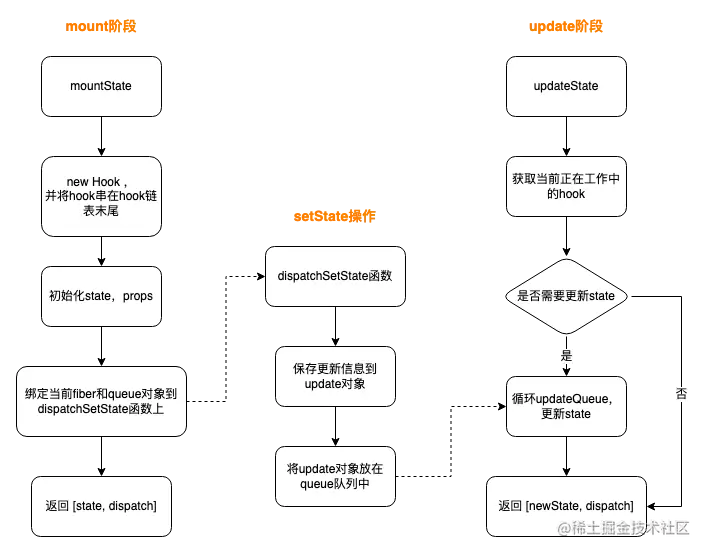React useState 原理
简介
当你试着去了解hooks原理的时候,你应该使用过react的class组件,或者已经使用过hooks了。
在React v16.8之前,React主要依赖class组件创建有状态组件,而无状态组件则采用函数式组件编写。这时期的函数式组件通常被称为无状态组件,因为它们缺乏内部状态,每次渲染都重新初始化函数,主要用于简单的渲染任务。
随着React v16.8引入Hooks,特别是useState,函数式组件得以拥有内部状态,不再仅限于简单渲染。useState允许函数式组件在执行周期之间保持状态,使其在多次渲染之间保留状态信息。这一改变使函数式组件具备了更类似class组件的能力,同时保持了简洁和清晰的语法。
通过使用useState等Hooks,函数式组件能更灵活地处理内部状态,使开发者能方便地在函数式组件中进行状态管理和副作用处理。这一特性的引入是React发展中的重要一步,也是函数式组件逐渐成为React应用主要组件形式的推动因素之一。
本文将探讨以下几点问题
useState如何能让函数式组件有了状态- 为什么不能在条件语句中声明
hooks hooks为什么要声明在组件的最顶部
React Hooks
我们从这个文件开始看:packages/react/src/ReactHooks.js
可以看到:这个文件是一个React源代码文件,其中包含了一些React钩子(hooks)的实现。
ReactHooks.js伪代码如下:
// 伪代码 - React Hooks 实现文件
import ReactCurrentDispatcher from './ReactCurrentDispatcher';
// 获取当前的dispatcher
function resolveDispatcher() {
const dispatcher = ReactCurrentDispatcher.current
return dispatcher
}
// useState钩子的实现
export function useState(initialState){
const dispatcher = resolveDispatcher();
return dispatcher.useState(initialState);
}我们在这里只关注两个函数,一个是useState,一个是resolveDispatcher
resolveDispatcher
resolveDispatcher函数中,可以看到了引用外部文件中的ReactCurrentDispatcher,我们去看看
// packages/react/src/ReactCurrentDispatcher.js
/**
* Keeps track of the current dispatcher.
*/
const ReactCurrentDispatcher = {
current: null,
};
export default ReactCurrentDispatcher;可以看到,该模块的主要作用是提供一个全局的、可被 React 内部访问的变量,用于存储当前的 dispatcher。
这有助于 React 内部和不同模块之间共享当前的 dispatcher 实例,以确保 hooks 能够在正确的上下文中执行。
useState
- 入参 - initialState
用过react hooks 的同学都知道,这是用来初始化state的值
- dispatcher.useState
不难发现, dispatcher 对象有一个名为 useState 的方法,它实际上会调用 React 内部的 useState 实现。
ReactFiberHooks
看到这,线索好像断掉了,于是我问了问GPT
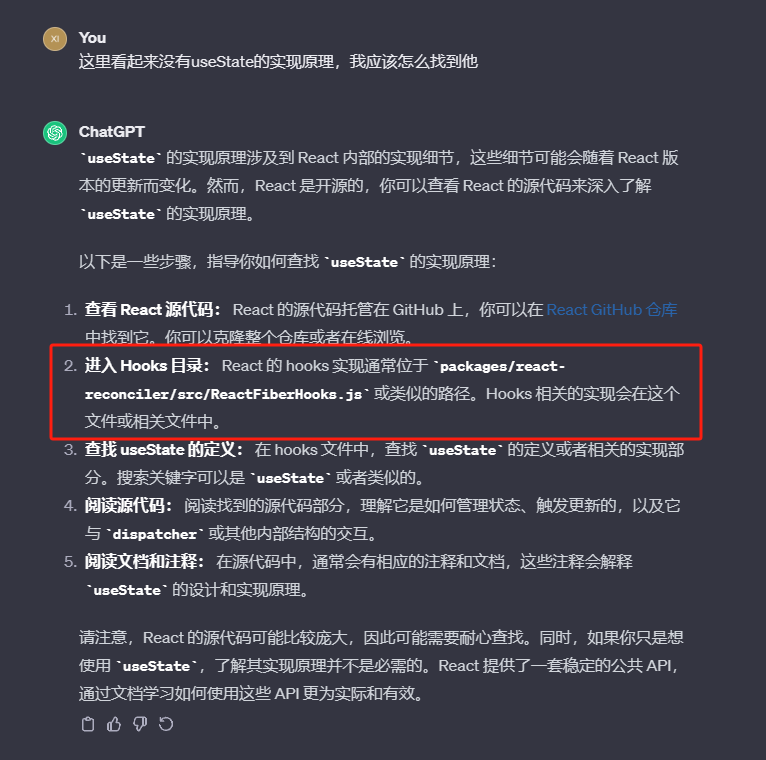
于是我们来到这个文件:packages/react-reconciler/src/ReactFiberHooks.js
打开文件一看,好家伙,4800多行。
之前我们了解到了ReactCurrentDispatcher这么个玩意,他提供了一个全局的变量,那么这个文件有没有用到?
果然,发现了这么两行代码,从shared/ReactSharedInternals引入,有ReactCurrentDispatcher、 ReactCurrentBatchConfig两个变量,其中一个就是我们熟悉的ReactCurrentDispatcher。
import ReactSharedInternals from 'shared/ReactSharedInternals';
const {ReactCurrentDispatcher, ReactCurrentBatchConfig} = ReactSharedInternals;ReactSharedInternals
进入到shared/ReactSharedInternals这个文件
import * as React from 'react';
const ReactSharedInternals =
React.__SECRET_INTERNALS_DO_NOT_USE_OR_YOU_WILL_BE_FIRED;
export default ReactSharedInternals;React.__SECRET_INTERNALS_DO_NOT_USE_OR_YOU_WILL_BE_FIRED的来源我就简单放一下,感兴趣的同学自己去看源码
// packages/react/src/React.js
import ReactSharedInternals from './ReactSharedInternalsClient';
export {
...
ReactSharedInternals as __SECRET_INTERNALS_DO_NOT_USE_OR_YOU_WILL_BE_FIRED,
...
};// packages/react/src/ReactSharedInternalsClient.js
import ReactCurrentDispatcher from './ReactCurrentDispatcher';
const ReactSharedInternals = {
ReactCurrentDispatcher,
ReactCurrentBatchConfig,
...
};
export default ReactSharedInternals;到这明白了,React.__SECRET_INTERNALS_DO_NOT_USE_OR_YOU_WILL_BE_FIRED其实就是我们最开始看到的这玩意
const ReactCurrentDispatcher = {
current: null,
};
export default ReactCurrentDispatcher;type Hook
好,现在回到packages/react-reconciler/src/ReactFiberHooks.js ,在该文件中,我们可以看到Hook的type
export type Hook = {
memoizedState: any, // 上次渲染时所用的 state
baseState: any, // 已处理的 update 计算出的 state
baseQueue: Update<any, any> | null, // 未处理的 update 队列(一般是上一轮渲染未完成的 update)
queue: UpdateQueue<any, any> | null, // 当前出发的 update 队列
next: Hook | null, // 指向下一个 hook,形成链表结构
};举个例子,用于说明 useState 在链表中的关系。
首先,在组件渲染的过程中,React 会为每个 useState 调用创建一个新的 Hook 对象。在这个例子中,我们有两个 useState,因此会有两个对应的 Hook 对象。
function MyComponent() {
const [count, setCount] = useState(0);
const [text, setText] = useState("Hello, React!");
return (
<div>
<p>Count: {count}</p>
<p>Text: {text}</p>
<button onClick={() => setCount(count + 1)}>Increment Count</button>
<button onClick={() => setText("New Text")}>Change Text</button>
</div>
);
}- 初始渲染时创建 Hook 对象:
// 初始渲染时创建的 Hook 链表
Hook (count)
-> Hook (text)
-> null在链表中,每个 Hook 对象的 next 属性指向下一个 Hook 对象,形成了链表结构。
- 执行更新时更新 Hook 对象:
// 执行更新后的 Hook 链表
Hook (count, updatedStateForCount)
-> Hook (text, updatedStateForText)
-> null在这个例子中,updatedStateForCount 和 updatedStateForText 分别表示更新后的状态。
每个 Hook 对象的 memoizedState 属性存储了上次渲染时使用的状态,而 baseState 存储了已处理的 update 计算出的状态。
ReactFiberBeginWork
来到react/packages/react-reconciler/src/ReactFiberBeginWork.js,注意看updateFunctionComponent函数,
function beginWork(
current: Fiber | null,
workInProgress: Fiber,
renderLanes: Lanes,
): Fiber | null {
// ...
case FunctionComponent: {
const Component = workInProgress.type;
const unresolvedProps = workInProgress.pendingProps;
const resolvedProps =
workInProgress.elementType === Component
? unresolvedProps
: resolveDefaultProps(Component, unresolvedProps);
return updateFunctionComponent(
current,
workInProgress,
Component,
resolvedProps,
renderLanes,
);
}
// ...
}function updateFunctionComponent(
current: null | Fiber,
workInProgress: Fiber,
Component: any,
nextProps: any,
renderLanes: Lanes,
) {
// ...
if (__DEV__) {
// ...
} else {
nextChildren = renderWithHooks(
current,
workInProgress,
Component,
nextProps,
context,
renderLanes,
);
hasId = checkDidRenderIdHook();
}
// ...
}renderWithHooks主要做了两件事:
- 用变量 currentlyRenderingFiber记录当前的 fiber node。使得useState能拿到当前 node的状态。
- 判断 hook api 挂载在那个对象上。首次渲染和后期的更新,挂载的对象是不同的
// react/packages/react-reconciler/src/ReactFiberHooks.js
export function renderWithHooks<Props, SecondArg>(
// 当前页面正在渲染的node,第一次渲染为null
current: Fiber | null,
// 新的node,用于下次页面更新
workInProgress: Fiber,
// 渲染组件的函数
Component: (p: Props, arg: SecondArg) => any,
// 组件的属性
props: Props,
// context
secondArg: SecondArg,
// fiber渲染过期时间
nextRenderLanes: Lanes,
): any {
// 将全局变量 renderLanes 设置为下一个渲染的优先级
renderLanes = nextRenderLanes;
// 将全局变量 currentlyRenderingFiber 设置为当前工作中的 Fiber 节点
currentlyRenderingFiber = workInProgress;
// ...
if (__DEV__) {
// ...
} else {
// 组件首次渲染,hook 从 HooksDispatcherOnMount 取
// 非首次渲染, hook 从 HooksDispatcherOnUpdate 取
ReactCurrentDispatcher.current =
current === null || current.memoizedState === null
? HooksDispatcherOnMount
: HooksDispatcherOnUpdate;
}
// ...
}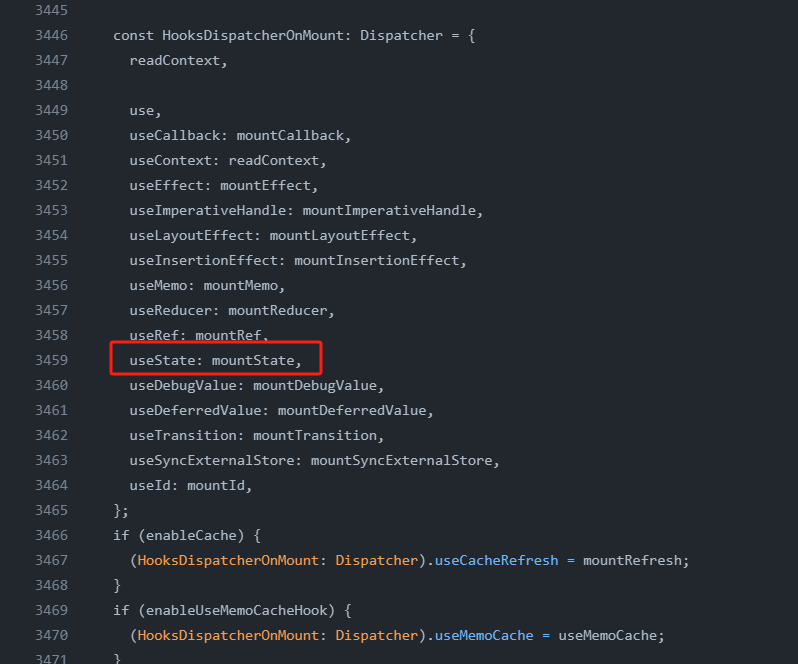
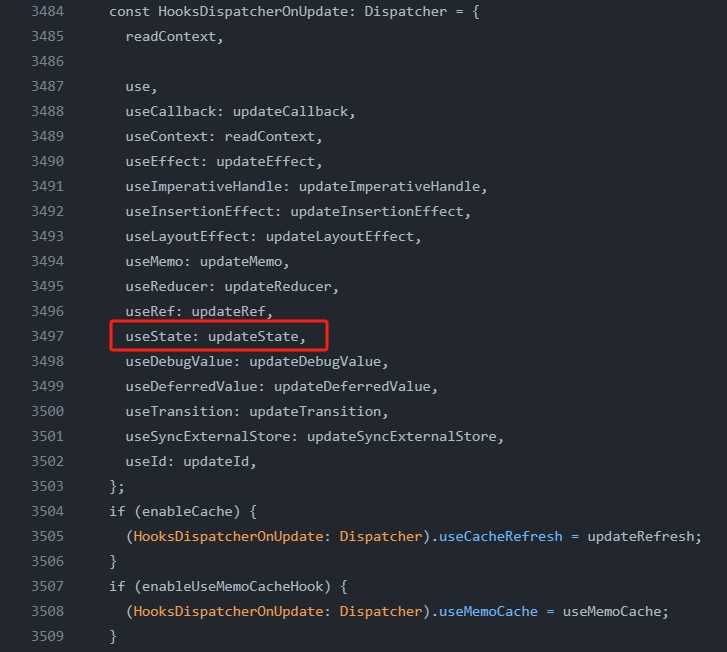
可以看到,在组件首次渲染的时候,useState = mountState;非首次渲染,useState = upStateState
mountState
function mountWorkInProgressHook(): Hook {
const hook: Hook = {
memoizedState: null,
baseState: null,
baseQueue: null,
queue: null,
next: null,
};
if (workInProgressHook === null) {
// 第一次打开页面,链表是空的
// 初始化currentlyRenderingFiber.memoizedState、workInProgressHook
// currentlyRenderingFiber表示当前正在被渲染的 Fiber 节点
// workInProgressHook表示当前正在工作的 Hook
currentlyRenderingFiber.memoizedState = workInProgressHook = hook;
} else {
// 不是第一个hook对象,就把新的hook放在链表后面
workInProgressHook = workInProgressHook.next = hook;
}
return workInProgressHook;
}
function mountStateImpl<S>(initialState: (() => S) | S): Hook {
// 创建一个新的 Hook 用于在组件生命周期中管理状态。
const hook = mountWorkInProgressHook();
// 如果初始状态是一个函数,则调用它以获取实际的初始状态值。
if (typeof initialState === 'function') {
initialState = initialState();
}
// 将 Hook 的 memoizedState 和 baseState 设置为初始状态。
hook.memoizedState = hook.baseState = initialState;
// 创建一个更新队列,用于管理状态更新。
const queue: UpdateQueue<S, BasicStateAction<S>> = {
// 待应用于状态的挂起更新。
pending: null,
// lanes 是一个位掩码(bitmask),每一位都代表一个优先级的更新。
// React 使用 lanes 来追踪每个 Fiber 节点(组件)的更新状态,以确定何时处理更新。
lanes: NoLanes,
// 负责分派更新到状态的函数。
dispatch: null,
// 在渲染期间用于计算下一个状态的约简器函数。
lastRenderedReducer: basicStateReducer,
// 上一次组件更新期间渲染的最后状态。
lastRenderedState: (initialState: any),
};
// 将更新队列附加到 Hook 上。
hook.queue = queue;
// 返回初始化的 Hook。
return hook;
}
function mountState<S>(
initialState: (() => S) | S,
): [S, Dispatch<BasicStateAction<S>>] {
const hook = mountStateImpl(initialState);
const queue = hook.queue;
const dispatch: Dispatch<BasicStateAction<S>> = (dispatchSetState.bind(
null,
currentlyRenderingFiber,
queue,
): any);
queue.dispatch = dispatch;
return [hook.memoizedState, dispatch]; // 返回 state , 以及 setState 函数
}updateState
function updateState<S>(
initialState: (() => S) | S,
): [S, Dispatch<BasicStateAction<S>>] {
return updateReducer(basicStateReducer, initialState);
}可以看到其实 updateState 的内部逻辑,其实是就是 updateReducer,所以其实 useState 和 useReducer 两个 hooks 其实做的是同一件事 => 更新 state
useState 和 useReduer 的关系:
useState 是 useReduer 的一个特殊情况,其传入的 reducer 是固定的 basicStateReducer,负责改变 state
useReducer 可以传入自定义的 reducer
updateState 做的事情,实际上就是拿到更新队列,循环队列,并根据每一个 update 对象对当前 hook 进行状态更新。最后返回最终的结果。
updateReducer
function updateReducer<S, I, A>(
reducer: (S, A) => S,
initialArg: I,
init?: I => S,
): [S, Dispatch<A>] {
const hook = updateWorkInProgressHook();
return updateReducerImpl(hook, ((currentHook: any): Hook), reducer);
}updateWorkInProgressHook
// 在 React 的渲染和更新过程中,会涉及到多次调用这个函数,以确保正确地维护和更新 Hook 的状态信息。
function updateWorkInProgressHook(): Hook {
// 此函数用于处理更新以及由渲染阶段更新触发的重新渲染。
// 它假设存在当前可克隆的 Hook,或者可以用作基础的上一个渲染传递中的工作中 Hook。
let nextCurrentHook: null | Hook;
// 当 currentHook 为 null 时,表示当前是首次渲染
if (currentHook === null) {
// 如果有备用节点 (currentlyRenderingFiber.alternate),则从备用节点的记忆状态中获取
const current = currentlyRenderingFiber.alternate;
if (current !== null) {
nextCurrentHook = current.memoizedState;
} else {
nextCurrentHook = null;
}
} else {
nextCurrentHook = currentHook.next;
}
let nextWorkInProgressHook: null | Hook;
// 如果当前工作中的 Hook (workInProgressHook) 为 null,则表示这是首次渲染,
// 将当前渲染的 Fiber 节点的记忆状态设置为下一个工作中的 Hook (currentlyRenderingFiber.memoizedState)。
if (workInProgressHook === null) {
nextWorkInProgressHook = currentlyRenderingFiber.memoizedState;
} else {
nextWorkInProgressHook = workInProgressHook.next;
}
// 如果 nextWorkInProgressHook 不为 null,说明已经有一个工作中的 Hook,可以直接复用。
if (nextWorkInProgressHook !== null) {
workInProgressHook = nextWorkInProgressHook;
nextWorkInProgressHook = workInProgressHook.next;
currentHook = nextCurrentHook;
} else {
// 否则,表示需要从当前 Hook 克隆一个新的 Hook,并更新当前 Hook 为下一个当前 Hook。
// 如果 nextCurrentHook 为 null,表示这是初始渲染。
if (nextCurrentHook === null) {
const currentFiber = currentlyRenderingFiber.alternate;
// 如果有备用节点 (currentlyRenderingFiber.alternate),则抛出错误,因为在初始渲染时不应该调用更新 Hook。
if (currentFiber === null) {
// 这是初始渲染。当组件挂起、恢复,然后渲染额外的 Hook 时,会进入此分支。
// 实际上不应该到达这里,因为我们应该首先切换到挂载分发器。
throw new Error(
'Update hook called on initial render. This is likely a bug in React. Please file an issue.',
);
} else {
// 否则,说明这是一个更新,抛出错误,因为在更新时应该始终有一个当前 Hook。
// This is an update. We should always have a current hook.
throw new Error('Rendered more hooks than during the previous render.');
}
}
// 更新当前 Hook 为下一个当前 Hook。
currentHook = nextCurrentHook;
const newHook: Hook = {
memoizedState: currentHook.memoizedState,
baseState: currentHook.baseState,
baseQueue: currentHook.baseQueue,
queue: currentHook.queue,
next: null,
};
if (workInProgressHook === null) {
// 如果当前工作中的 Hook 为 null,说明这是列表中的第一个 Hook
// 将当前渲染的 Fiber 节点的记忆状态设置为新的工作中的 Hook。
currentlyRenderingFiber.memoizedState = workInProgressHook = newHook;
} else {
// 否则,将新的工作中的 Hook 添加到列表末尾。
workInProgressHook = workInProgressHook.next = newHook;
}
}
return workInProgressHook;
}updateReducerImpl
function updateReducerImpl<S, A>(
hook: Hook,
current: Hook,
reducer: (S, A) => S,
): [S, Dispatch<A>] {
const queue = hook.queue;
// 检查队列是否存在
if (queue === null) {
throw new Error(
'应该有一个队列。这可能是 React 中的一个 bug,请报告一个问题。',
);
}
queue.lastRenderedReducer = reducer;
// 获取基本队列
let baseQueue = hook.baseQueue;
// 获取未处理的更新队列
const pendingQueue = queue.pending;
if (pendingQueue !== null) {
// 有未处理的更新,将它们添加到基本队列中
if (baseQueue !== null) {
// 合并未处理队列和基本队列
const baseFirst = baseQueue.next;
const pendingFirst = pendingQueue.next;
baseQueue.next = pendingFirst;
pendingQueue.next = baseFirst;
}
current.baseQueue = baseQueue = pendingQueue;
queue.pending = null;
}
if (baseQueue !== null) {
// 有队列需要处理
const first = baseQueue.next;
let newState = hook.baseState;
let newBaseState = null;
let newBaseQueueFirst = null;
let newBaseQueueLast: Update<S, A> | null = null;
let update = first;
do {
// 从更新中删除 OffscreenLane 位,以区分在隐藏树中进行的更新和已在进入 Offscreen 树时添加到 renderLanes 的更新。
const updateLane = removeLanes(update.lane, OffscreenLane);
const isHiddenUpdate = updateLane !== update.lane;
// 假设有以下场景:
// 组件A的一个异步操作触发了更新。
// 在更新时,React 可能会将更新的优先级(updateLane)设置为比当前渲染的优先级(renderLanes)更低的优先级。
// 如果异步操作触发的更新的优先级较低,那么在 React 异步渲染的环境中,就有可能会将这个更新跳过,不立即处理。
// 这样做的原因是为了优先处理那些更紧急、更高优先级的更新,以提高用户界面的响应性。
const shouldSkipUpdate = isHiddenUpdate
? !isSubsetOfLanes(getWorkInProgressRootRenderLanes(), updateLane)
: !isSubsetOfLanes(renderLanes, updateLane);
if (shouldSkipUpdate) {
// 跳过更新
// ...
} else {
// 此更新具有足够的优先级。
// 检查这是否是一次乐观更新。
// 在 React 中,乐观更新常常与状态管理和异步操作有关。具体来说,乐观更新的流程通常如下:
// 1、用户触发某个操作,例如提交一个表单、点击一个按钮。
// 2、应用程序会立即更新界面,展示操作的预期结果。
// 3、同时,应用程序会发起实际的操作,比如向服务器发送请求。
// 4、当实际操作完成后,根据实际结果更新界面。如果实际操作成功,则保持界面的状态不变;如果失败,则可能需要回滚或采取其他错误处理措施。
const revertLane = update.revertLane;
if (!enableAsyncActions || revertLane === NoLane) {
// 这不是一次乐观更新,我们现在将应用它。但是,如果之前有被跳过的更新,我们需要将此更新保留在队列中,以便以后可以重新基于它。
if (newBaseQueueLast !== null) {
const clone: Update<S, A> = {
lane: NoLane,
revertLane: NoLane,
action: update.action,
hasEagerState: update.hasEagerState,
eagerState: update.eagerState,
next: (null: any),
};
// 在React的更新机制中,更新以链表的形式存在,每个更新都是一个节点。
// newBaseQueueLast 的作用是指向这个链表中的最后一个节点,以方便在更新队列的尾部添加新的更新。
newBaseQueueLast = newBaseQueueLast.next = clone;
}
} else {
// 乐观更新
// ...
}
const action = update.action;
if (shouldDoubleInvokeUserFnsInHooksDEV) {
reducer(newState, action);
}
if (update.hasEagerState) {
// 如果此更新是状态更新(而不是 reducer)并且已急切处理,我们可以使用急切计算的状态
newState = ((update.eagerState: any): S);
} else {
newState = reducer(newState, action);
}
}
update = update.next;
} while (update !== null && update !== first);
if (newBaseQueueLast === null) {
newBaseState = newState;
} else {
newBaseQueueLast.next = (newBaseQueueFirst: any);
}
// 当 newState 和 hook.memoizedState 相同时,说明状态没有发生变化。
// 在 React 中,如果状态没有发生变化,React 通常会避免不必要的重新渲染,以提高性能。
if (!is(newState, hook.memoizedState)) {
markWorkInProgressReceivedUpdate();
}
hook.memoizedState = newState;
hook.baseState = newBaseState;
hook.baseQueue = newBaseQueueLast;
queue.lastRenderedState = newState;
}
if (baseQueue === null) {
// `queue.lanes` 用于交织过渡。一旦队列为空,我们可以将其设置回零。
queue.lanes = NoLanes;
}
const dispatch: Dispatch<A> = (queue.dispatch: any);
return [hook.memoizedState, dispatch];
}enqueueRenderPhaseUpdate
function enqueueRenderPhaseUpdate<S, A>(
queue: UpdateQueue<S, A>,
update: Update<S, A>,
): void {
// This is a render phase update. Stash it in a lazily-created map of
// queue -> linked list of updates. After this render pass, we'll restart
// and apply the stashed updates on top of the work-in-progress hook.
didScheduleRenderPhaseUpdateDuringThisPass = didScheduleRenderPhaseUpdate =
true;
const pending = queue.pending;
if (pending === null) {
// This is the first update. Create a circular list.
update.next = update;
} else {
update.next = pending.next;
pending.next = update;
}
queue.pending = update;
}通过enqueueRenderPhaseUpdate我们可以看到,实际上,dispatchSetState 这个函数主要做了两件事情。
- 第一件事:创建了一个
update对象,这个对象上面保存了本次更新的相关信息,包括新的状态值action。 - 第二件事:将所有的
update对象串成了一个环形链表,保存在我们hook对象的queue.pending属性上面。
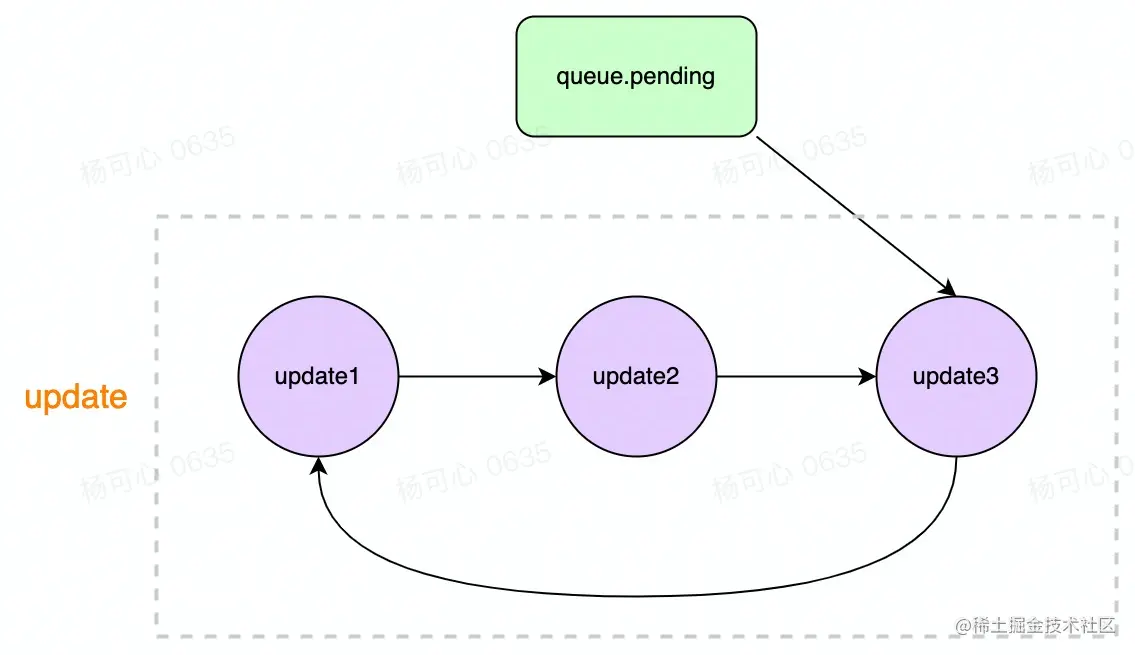
使用环形链表的意义: 整个环形链表变量我们叫它
update,使得queue.pending = update那么此时queue.pending的最近一次更新,就是update,最早的一次更新是update.next这样就快速定位到最早的一次更新了 如果是单链表,想找到最早的 一次更新,需要一层一层往下找 环形链表一次就找到了
总结
React 通过记录每次更新的状态来实现对组件状态的追踪和管理。这种记录的作用主要有以下几个方面:
- 状态的持久化: React Hooks 中的状态是持久化的,即它们在组件的多次渲染之间保持不变。每次组件重新渲染时,React 会使用之前的状态作为新的状态的基础,通过对状态的修改和更新来实现组件状态的管理。这就是
memoizedState和baseState的作用,它们记录了状态的当前值和基础值。 - 更新队列的构建: 当组件中的状态发生变化时,React 不会立即执行更新,而是将更新放入更新队列中,通过
baseQueue来记录。这样可以确保在一次组件渲染的过程中,所有的状态更新都被收集到一个队列中,并在合适的时机进行批量处理。 - 更新的持久化: React 通过更新队列(
baseQueue)来记录组件状态的更新,每个更新都是一个节点,这些节点形成一个链表结构。这样,React 在处理更新时可以按照链表的顺序依次执行,并且能够正确处理异步和并发场景。 - 优化性能: 通过记录每次更新的状态和更新队列,React 可以在渲染过程中避免重复的计算和处理。只有发生真正的状态变化时,React 才会进行更新,提高了性能。
注意:
多次调用setState,也会在
baseQueue生成多个更新节点。但React 中的状态更新并不是立即执行的,而是在一次组件更新的过程中进行批量处理。
React 通过更新队列(
baseQueue)和协调阶段来实现对状态更新的批量处理,确保只有最终的状态变化会触发一次实际的渲染。
